Themed collection 2020 Inorganic Chemistry Frontiers HOT articles

Lithium nickel borides: evolution of [NiB] layers driven by Li pressure
Insertion of additional Li atoms into the Li-monolayer in the structures of layered LiNiB polymorphs induces the deformation of [NiB] layers and alters their stacking, however, does not affect magnetic properties.
![Graphical abstract: Lithium nickel borides: evolution of [NiB] layers driven by Li pressure](/en/Image/Get?imageInfo.ImageType=GA&imageInfo.ImageIdentifier.ManuscriptID=D0QI01150A&imageInfo.ImageIdentifier.Year=2021)
Inorg. Chem. Front., 2021,8, 1675-1685
https://doi.org/10.1039/D0QI01150A
Insight into the structure–property relationship of two-dimensional lead-free halide perovskite Cs3Bi2Br9 nanocrystals under pressure
Pressure-induced phase transformation and narrowed band gap of two-dimensional lead-free halide perovskite Cs3Bi2Br9 nanocrystals.

Inorg. Chem. Front., 2021,8, 1410-1415
https://doi.org/10.1039/D0QI01300E
Highly enhanced H2 evolution of MoO3/g-C3N4 hybrid composites based on a direct Z-scheme photocatalytic system
A direct Z-scheme MoO3/g-C3N4 heterojunction with appropriate oxygen vacancies is successfully fabricated via an in situ method of a one-pot pyrolysis strategy.
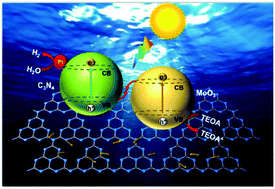
Inorg. Chem. Front., 2021,8, 1154-1165
https://doi.org/10.1039/D0QI01222J
A dual-protection strategy using CMK-3 coated selenium and modified separators for high-energy Al–Se batteries
Al–Se batteries designed by a dual-protection strategy greatly block the intermediate products dissolved in the electrolyte, delivering a high capacity of 651 mA h g−1 after 400 cycles at 1000 mA g−1.

Inorg. Chem. Front., 2021,8, 1030-1038
https://doi.org/10.1039/D0QI01302A
Ultralow thermal conductivity in the quaternary semiconducting chalcogenide Cs4[Ho26Cd7Se48] with an unprecedented closed cavity architecture
A quaternary semiconducting chalcogenide, Cs4[Ho26Cd7Se48], with an unprecedented closed cavity architecture exhibits ultralow thermal conductivity.
![Graphical abstract: Ultralow thermal conductivity in the quaternary semiconducting chalcogenide Cs4[Ho26Cd7Se48] with an unprecedented closed cavity architecture](/en/Image/Get?imageInfo.ImageType=GA&imageInfo.ImageIdentifier.ManuscriptID=D0QI01240H&imageInfo.ImageIdentifier.Year=2021)
Inorg. Chem. Front., 2021,8, 1049-1055
https://doi.org/10.1039/D0QI01240H
Confinement of PMo12 in hollow SiO2-PMo12@rGO nanospheres for high-performance lithium storage
High-performance lithium storage was achieved by the confinement of PMo12 in hollow SiO2-PMo12@rGO nanocomposites.

Inorg. Chem. Front., 2021,8, 352-360
https://doi.org/10.1039/D0QI01207F
Ba2B7O12F with novel FBB [B7O16F] and deep-ultraviolet cut-off edge
A new fluorooxoborate Ba2B7O12F features novel FBB [B7O16F] and two different sizes of channels in its anionic structure, which possesses a deep-ultraviolet cutoff edge of 180 nm and a large bandgap of 6.67 eV.
![Graphical abstract: Ba2B7O12F with novel FBB [B7O16F] and deep-ultraviolet cut-off edge](/en/Image/Get?imageInfo.ImageType=GA&imageInfo.ImageIdentifier.ManuscriptID=D0QI00924E&imageInfo.ImageIdentifier.Year=2021)
Inorg. Chem. Front., 2021,8, 339-343
https://doi.org/10.1039/D0QI00924E
A rapid in situ synthesis of wide-spectrum CD@BaCl2 phosphors via anti-solvent recrystallization for white LEDs
A facile and rapid in situ recrystallization strategy that can anchor carbon dots in an inorganic barium chloride solid medium is applied to produce wide-spectrum hybrid CD@barium chloride phosphors that show good photoluminescence for WLED aplications.
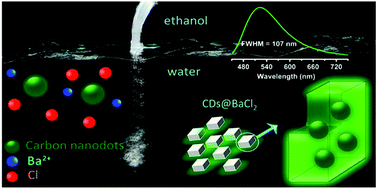
Inorg. Chem. Front., 2020,7, 4845-4853
https://doi.org/10.1039/D0QI01054E
Metal carbide/Ni hybrids for high-performance electromagnetic absorption and absorption-based electromagnetic interference shielding
Metal carbide/Ni hybrid nanostructures are designed to realize electromagnetic absorption and absorption-based electromagnetic interference shielding (EIS). An EIS effectiveness larger than 60 dB is achieved with an absorption contribution of 98.9%.

Inorg. Chem. Front., 2020,7, 4832-4844
https://doi.org/10.1039/D0QI00687D
Improvement in the stability of γ-CsPbI3 nanowires enabled by lattice immobilization through the Pb–O anchor in SBA-15
γ-CsPbI3 nanowires crystallized inside channels of mesoporous SBA-15 template, exhibit improved phase stability from the Pb and O anchoring.
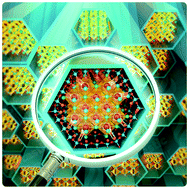
Inorg. Chem. Front., 2020,7, 4572-4579
https://doi.org/10.1039/D0QI01069C
Element table of TM-substituted polyoxotungstates for direct electrocatalytic reduction of nitric oxide to ammonia: a DFT guideline for experiments
We screened out NiII, CoII, CuII, PdII, PtII, and AgI substituted heteropolytungstates as promising electrocatalysts for nitric oxide to ammonia with high activity and high selectivity.

Inorg. Chem. Front., 2020,7, 4507-4516
https://doi.org/10.1039/D0QI01014F
Near-infrared phosphorescent terpyridine osmium(II) photosensitizer complexes for photodynamic and photooxidation therapy
NIR phosphorescent terpyridine Os(II) complexes can produce singlet oxygen and oxidize NADH under both blue and red light irradiation.

Inorg. Chem. Front., 2020,7, 4020-4027
https://doi.org/10.1039/D0QI00846J
Orientation mapping of Rabi frequencies in a rare-earth molecular qudit
Utilizing the S = 7/2 4f spin and the D4 symmetry of a Gd(III) complex, we propose and demonstrate an eight-leveled rare-earth molecular qudit, which can be coherently manipulated between adjacent energy levels with precompiled pulse durations.
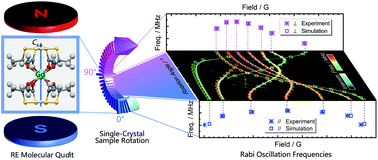
Inorg. Chem. Front., 2020,7, 3875-3881
https://doi.org/10.1039/D0QI00784F
Syntheses, structures and characterization of non-centrosymmetric Rb2Zn3(P2O7)2 and centrosymmetric Cs2M3(P2O7)2 (M = Zn and Mg)
Three phosphates Rb2Zn3(P2O7)2 and Cs2M3(P2O7)2 (M = Zn and Mg) were successfully synthesized by a high-temperature solution method.

Inorg. Chem. Front., 2020,7, 3482-3490
https://doi.org/10.1039/D0QI00689K
Excellent lightweight carbon-based microwave absorbers derived from metal–organic frameworks with tunable electromagnetic properties
Upon introducing Gibbs free energy to effectively control the final products, the as-prepared carbon-based composites show excellent absorbing ability at 1.4 mm.
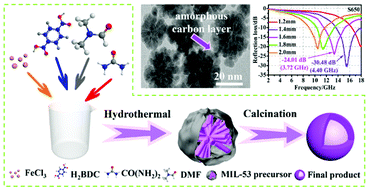
Inorg. Chem. Front., 2020,7, 1667-1675
https://doi.org/10.1039/D0QI00099J
Tunable hierarchical surfaces of CuO derived from metal–organic frameworks for non-enzymatic glucose sensing
A facile thermal treatment is conducted to prepare nanosphere stacking CuO derived from Cu-MOF, which achieves good glucose sensing performance and is expected to be effective for developing non-enzyme and non-invasive glucose sensors.
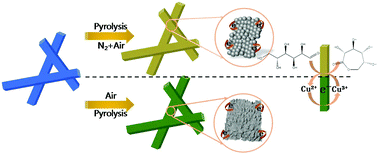
Inorg. Chem. Front., 2020,7, 1512-1525
https://doi.org/10.1039/D0QI00104J
Synthesis of Fe3C@porous carbon nanorods via carbonizing Fe complexes for oxygen reduction reaction and Zn–air battery
The FeCNRs were controlled prepared via carbonizing the Fe complexes and their activities on ORR was found to be suitable for Zn–air battery application.
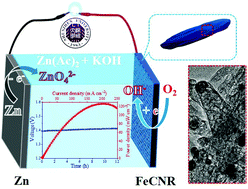
Inorg. Chem. Front., 2020,7, 889-896
https://doi.org/10.1039/C9QI01544B